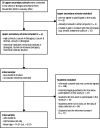Subclinical attention-deficit hyperactivity disorder symptoms and unhealthy lifestyle behaviours
- PMID: 39359149
- PMCID: PMC11536216
- DOI: 10.1192/bjo.2024.785
Subclinical attention-deficit hyperactivity disorder symptoms and unhealthy lifestyle behaviours
Abstract
Background: Literature emphasises the importance of identifying and intervening in the adoption of unhealthy lifestyle behaviours (ULBs) during adolescence at an early stage, to mitigate their long-term detrimental effects. Among the possible associated factors contributing to ULBs, attention-deficit hyperactivity disorder (ADHD) has been shown to play an important role. However, little is known about ADHD subclinical manifestations.
Aims: The present study aimed to bridge the gap in the literature and shed light on the relationship between subclinical ADHD and early adoption of ULBs during adolescence. Through a clinimetric approach, prevalence of ULBs, severity of ADHD symptoms and psychosocial factors (i.e. allostatic overload, abnormal illness behaviour, quality of life, psychological well-being) were investigated among adolescents. The associations between different degrees of ADHD, ULBs and psychosocial factors were also explored.
Method: This multicentre cross-sectional study involved 440 adolescents (54.5% females; mean age 14.21 years) from six upper secondary schools. Participants completed self-report questionnaires on sociodemographic characteristics, ULBs, ADHD symptoms and psychosocial factors.
Results: The most common ULBs were energy drinks/alcohol consumption and problematic smartphone use. Of the sample, 22% showed subclinical ADHD and 20.2% showed clinical ADHD. The subclinical ADHD group showed several ULBs (i.e. altered mindful eating, impaired quality of sleep, problematic technology use) and psychosocial factors, akin to those of ADHD group and different from peers without ADHD symptoms.
Conclusions: Since subclinical ADHD manifestation is associated with ULBs, similarly to clinical ADHD, identifying subthreshold symptoms during adolescence is crucial, as it could improve health-related outcomes in adulthood across different domains.
Keywords: Attention-deficit hyperactivity disorder; adolescence; psychological well-being; subclinical symptoms; unhealthy lifestyle behaviours.
Conflict of interest statement
None.
References
LinkOut - more resources
Full Text Sources
Miscellaneous


